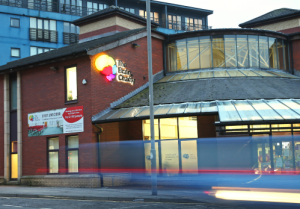
SPOTLIGHT ON: Liverpool’s Everyman – an accessible and disability friendly theatre in Merseyside
Merseyside's Everyman Theatre is committed to being a safe space for people with all forms of disability
As a charity that provides inclusive events for our neurological community, we are particularly interested and excited by venues that have accessibility at the forefront of what they offer.
In 2014, The Brain Charity’s Events and Fundraising Officer Gregory Kearns was lucky enough to get a tour of the then-new Everyman Theatre building, and was struck by the wheelchair accessible lighting rig – an amazing thing to see and well ahead of its time.
Earlier this year, Gregory returned to The Everyman as it reopened post-pandemic to find out more about the theatre’s evolution and its continuing commitment to accessibility.

A history of the Everyman Theatre in Liverpool
The Everyman Theatre has been part of Liverpool’s culture for the past 60 years. Completely rebuilt during the early 2010s, the RIBA Stirling prize winning architecture incorporates a level of accessibility that provides a welcoming safe space for its audiences.
Standing on the site of Hope Hall, a former place of worship in the mid-1800s, the Everyman came to life in the early 1960s.
It was part of the Beat revolution, as The Beatles climbed the charts and the Liverpool Scene beat poets took to the boards of the Everyman.
Despite renovations during the following decade, the building was in clear need of a makeover.
The architectural studio Haworth Tompkins were commissioned for its 21st Century makeover, and when it came to the consultation of the rebuild, accessibility was to the fore.
We met The Everyman’s Venue and Events Planner Rachel Elliott-Newton as theatre-goers flocked back after a two-year coronavirus hiatus.
Rachel, who started out in the company’s Young Everyman Playhouse and returned to the fold after finishing her degree at Edinburgh University, said: “The Everyman has been one of the lynchpins of the city.
“The model of the bistro within a theatre setting has been taken up by many other creative spaces, and I was fortunate enough to rejoin at a very exciting time, when the building was reopened in 2014.
“We always try to engage with any unconscious biases to enable all in the city to feel welcome.”

How to make theatres accessible and disability-friendly
The Everyman is not a venue which would simply pay lip service to accessibility, and, while no venue can claim to be fully accessible, Rachel concedes “it’s as near as we can possibly get”.
Staff at The Everyman have undertaken Safe Space training and worked with the Anthony Walker Foundation to ensure they are thinking about accessibility in a wide variety of ways, not just physical and neurodivergence.
There are also chair lifts, a shower room, a disabled access lift and an awareness that each visitor’s physical or emotional needs may be different.
Staff have a robust set of checks and balances in place and use the maxim ‘keep performances on stage’.
Rachel explains: “We don’t know what people’s backgrounds are when they arrive in the theatre, so it’s about making it safe for everyone.
“We’ve always pushed the boundaries and have always held each other to account.
“We own our mistakes and learn from them and there’s no culture of blame.
“We always keep the person in mind, not the disability and we minimise any drama surrounding situations.”
Engaging with criticism around disability and accessibility is vital
The building itself has an engaging buzz (and that’s just the beehives on the roof!) and the bespoke nature of the theatre has enabled accessibility changes to evolve alongside green energy and a modern façade.

There is a rich history contained with the creative space (not surprising, as it contains 25,000 old bricks from the previous Everyman) and a willingness to build on this to create, as Rachel puts it, “a feeling of agency”.
Rachel said: “We look at every person on a case-by-case basis.
“We try to get it right every time – but get it wrong and people will be vocal.
“Navigating social media feedback is difficult as lots of conversations are public – an inward reflection of being a safe place.
“Dynamically, we look at this as a way of asking ourselves – where did those opportunities get lost?”
Why is theatre accessibility so important?
With national and international traffic regularly coming through its front doors, the Everyman has a genuine desire to fix any issues.
Its CEO Mark Da Vanzo took over just as the pandemic struck, and, due to an underlying philosophy of treating everyone with kindness, it seems the Everyman is in good hands.
Rachel said: “As a place to work, it just gets better and better.
“Our engagement in the community is rooted in our ability to make the theatre accessible to all.”
The Brain Charity’s SPOTLIGHT ON series highlights the work being carried out to raise awareness of different conditions by charities, groups and individuals. To submit an article, please email us.
Categories: Guest blogs, Spotlight on series
Published: 30 August 2022
















